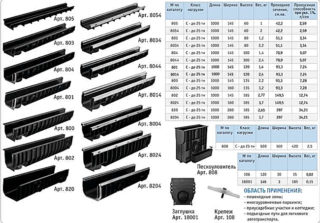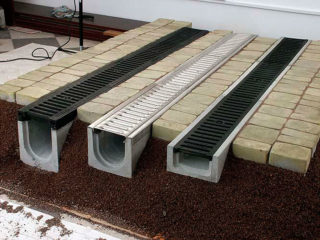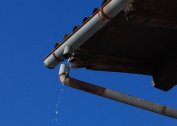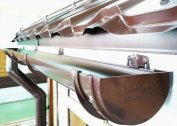Drainage trays are part of the drainage system and divert streams of rain or melt water from roads, buildings and household plots. They are a complex of gutters transporting water to a sewer. Installation of structures is simple, labor costs are minimal, but in some cases the use of special equipment will be required. Installation is carried out where it is impossible to equip a deep rainwater system.
Types and arrangement of drainage trays
The four main varieties of products differ in configuration. Trays can be:
- Sewage. In the form of a rectangle with a gutter.
- Box-shaped. In the shape of the letter P with trellised top.
- Slotted. In the upper part of the case there is a gap - the entire length or intermittent.
- Curb. A variation of the previous type, with a L-shaped protrusion covering the slit-like opening.
Tray designs are subdivided according to the material used for production. Polymeric products are popular because of their accessibility and low weight, which makes it easier to lay plastic drainage models of trays. Resistance to external negative influence, anticorrosion properties are also considered to be advantages. But the products are less durable compared to concrete counterparts. Plastic models can be destroyed during floods or under the influence of mechanical loads. Prices for them start from 450 rubles.
Metal structures are thicker, weigh more and have a corrosion-resistant coating. Usually they are made of cast iron. These are durable products with heavy weight. Installation requires special equipment. The most inexpensive ones cost 2200 rubles.
Massive and durable reinforced concrete products are not afraid of aggressive external influences. It is possible to install concrete drainage models of trays only with the help of special equipment. Their cost starts from 300 rubles.
A compromise between reinforced concrete and plastic is polymer concrete trays. They are stronger than polymer, resistant to stress and wear. But they cost more than plastic and concrete - from 1300 rubles.
Since you can only mount plastic devices with your own hands without the involvement of professionals, when drawing up an estimate, you also need to take into account the prices of works on installing drainage trays. Their cost ranges from 1000 to 2000 rubles per linear meter and depends on the dimensions of the tray, its design, the quality of the soil and the special equipment used.
Criterias of choice
 Choosing tray structures for water disposal, first of all, they look at the mass and overall performance of the products. To avoid errors during the selection process, take into account the characteristics of the material, the installation height. All these characteristics affect the planned volume of water that will be diverted from the territory. The place where the trays will be installed also plays an important role.
Choosing tray structures for water disposal, first of all, they look at the mass and overall performance of the products. To avoid errors during the selection process, take into account the characteristics of the material, the installation height. All these characteristics affect the planned volume of water that will be diverted from the territory. The place where the trays will be installed also plays an important role.
When selecting the appropriate type of tray, the throughput, which depends on the amount of moisture in the area from which water is required to be drained, and the largest load, are taken into account. The last indicator must be indicated on the product labeling:
- A 15. Storm trays with a small load - up to 1.5 tons. Suitable for sports grounds, pedestrian areas. They are installed under garden paths on a personal plot.
- At 125. Able to withstand up to 12.5 tons. Great choice for garages, cottages. They can be installed around the perimeter of the house.
- With 250. Provide a load of up to 25 tons, suitable for installation along highways.
- D 400. Hold up to 40 tons. Suitable for places where heavy equipment, parking lots.
- E 600. Maximum load - up to 60 tons. Install at airports.
Product dimensions are also selected depending on the abundance of surface runoff in a particular area.
Installation Steps
 Regardless of the configuration and material of manufacture, the trays are mounted in specially dug ditches. A screed made of concrete with a thickness of 10 cm acts as the bottom. The sides of the trenches are made in the form of slopes of concrete. The thickness at the base should be at least 100 mm on each side.
Regardless of the configuration and material of manufacture, the trays are mounted in specially dug ditches. A screed made of concrete with a thickness of 10 cm acts as the bottom. The sides of the trenches are made in the form of slopes of concrete. The thickness at the base should be at least 100 mm on each side.
Before starting work on the arrangement of the structure, a clear diagram is outlined, where the location of all nodes of the stormwater will be indicated.
Trays can be installed in a spot way in places of the greatest accumulation of water. But more often they use a linear type of drainage, where the products are one after another. This option is chosen, for example, when installing drainage trays around the perimeter of a private house on the border of the blind area.
How to mount the device:
- Dig a trench 15 cm deeper than the height of the product and wider 30 cm.
- At the bottom of the moat, build a cement-sand cushion and carefully compact it. The thickness of the rammed layer should be at least 10 cm. It should be borne in mind that the laying of the drainage trays is carried out at a slope to the place of the sewer drain - at least 10 mm per meter of length.
- Before laying the tray, cover the pillow with dense polyethylene or glassine for waterproofing.
- Install the formwork to fill the concrete base. For the bottom of the cage, only a durable solution of at least B25 is suitable, capable of withstanding heavy loads.
- Level the storm devices in compliance with the slope. The gaps between the trays must be filled with a polyurethane sealant, which will provide a waterproof connection. It does not lose flexibility for a long time under mechanical and dynamic loads. On the sides of the tray, place fasteners and spacers before pouring concrete.
- Fit the plugs and fittings for the drain pipe outlet.
- Fill the side faces of the concrete holder flush with the coating on the ground.
To create additional protection, it is recommended to equip a storm shower with a closed grate. It will also prevent large debris from entering the drainage system. Installation of the intake grille is 3-5 cm below the surface of the earth.
The trays are connected to each other by means of grooves. After installing the grate, the trays are covered with paving tiles, clinker or asphalt. It is important to overlay the product itself with plywood. After installing the surface coating, the plywood sheets must be pulled out. The resulting groove is filled with polyurethane sealant.
When installing a surface drainage system, it must be remembered that hard, compacted earth passes moisture in small quantities. Additional channels will be required. Loams cause bogging and suggest underground drainage. If the site has elevation differences, additional sleeves will be required.
With the correct selection and installation of storm water inlets, surface runoff will not accumulate even where it is not possible to install a deep water intake system, including near automobile roads.



